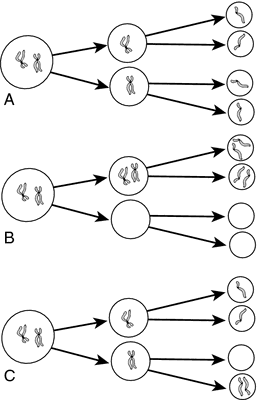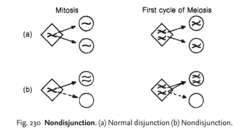nondisjunction
Also found in: Dictionary, Thesaurus, Encyclopedia, Wikipedia.
nondisjunction
[non″dis-jungk´shun]failure either of two homologous chromosomes to pass to separate cells during the first meiotic division, or of the two chromatids of a chromosome to pass to separate cells during mitosis or during the second meiotic division. As a result, one daughter cell has two chromosomes or two chromatids, and the other has none. If this happens during meiosis, an aneuploid individual (for example, a child with Down syndrome) may develop following fertilization.

Nondisjunction. Normal meiosis (A) is contrasted with failure of homologous chromosomes to separate in meiosis I (B) or of sister chromatids to separate in meiosis II (C). From Dorland's, 2000.
Miller-Keane Encyclopedia and Dictionary of Medicine, Nursing, and Allied Health, Seventh Edition. © 2003 by Saunders, an imprint of Elsevier, Inc. All rights reserved.
non·dis·junc·tion
(non'dis-jŭnk'shŭn), [MIM*257300]Failure of one or more pairs of chromosomes to separate at the meiotic stage of karyokinesis, with the result that both chromosomes are carried to one daughter cell and none to the other.
Farlex Partner Medical Dictionary © Farlex 2012
nondisjunction
(nŏn′dĭs-jŭngk′shən)n.
The failure of paired chromosomes or sister chromatids to separate and go to different cells during meiosis.
non′dis·junc′tion·al adj.
The American Heritage® Medical Dictionary Copyright © 2007, 2004 by Houghton Mifflin Company. Published by Houghton Mifflin Company. All rights reserved.
non·dis·junc·tion
(non'dis-jŭngk'shŭn)Failure of one or more pairs of chromosomes to separate at the meiotic stage of karyokinesis, with the result that both chromosomes are carried to one daughter cell and none to the other.
Medical Dictionary for the Health Professions and Nursing © Farlex 2012
nondisjunction
(nŏn″dĭs-jŭnk′shŭn)The failure of a pair of chromosomes to separate during meiosis, allowing one daughter cell to have two chromosomes and the other to have none.
See: illustrationMedical Dictionary, © 2009 Farlex and Partners
nondisjunction
the failure of chromosomes (in eukaryotes) to go to opposite poles during nuclear division, leading to unequal numbers of chromosomes in the daughter cells (see ANEUPLOIDY). See Fig. 230 . Nondisjunction produces abnormal numbers of both AUTOSOMES (e.g. DOWN'S SYNDROME) and SEX CHROMOSOMES (e.g. TURNERS SYNDROME).Collins Dictionary of Biology, 3rd ed. © W. G. Hale, V. A. Saunders, J. P. Margham 2005
Nondisjunction
A genetic term referring to an event which takes place during cell division, in which a genetic accident causes an egg or sperm cell to have 24 chromosomes, rather than the normal 23.
Mentioned in: Down Syndrome
Gale Encyclopedia of Medicine. Copyright 2008 The Gale Group, Inc. All rights reserved.

